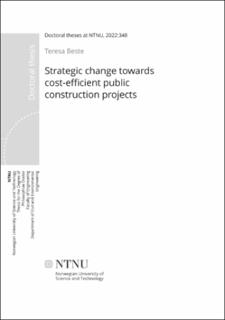| dc.contributor.advisor | Klakegg, Ole Jonny | |
| dc.contributor.advisor | Johansen, Agnar | |
| dc.contributor.advisor | Knudsen, Jørgen Kjetil | |
| dc.contributor.advisor | Fosse, Roar | |
| dc.contributor.author | Beste, Teresa | |
| dc.date.accessioned | 2022-11-08T11:55:39Z | |
| dc.date.available | 2022-11-08T11:55:39Z | |
| dc.date.issued | 2022 | |
| dc.identifier.isbn | 978-82-326-5936-4 | |
| dc.identifier.issn | 2703-8084 | |
| dc.identifier.uri | https://hdl.handle.net/11250/3030633 | |
| dc.description.abstract | The construction of public buildings, such as universities, museums, prisons or hospitals, creates value for society, but also comes at a cost. Limited public funds make it necessary to assure an optimal use of public resources. However, not all projects succeed with that, and complaints about a high cost level of public construction projects are numerous. Although academic research on construction project costs is abundant, the problem does not seem to have improved in practice.
This PhD-project has followed a two-year strategic initiative, which a public building commissioner pursued to increase the cost-efficiency of their construction projects. Costefficiency means achieving the desired result of a project with minimal resources invested into the project. In addition to investigate cost-efficiency on a project level, the PhD-project also looked at cost-efficiency at an organizational and a strategic level. The research purpose was to investigate how to achieve lasting change towards higher cost-efficiency in public construction projects. Three research questions have guided the research: (1) Which actions do public construction projects take to achieve higher cost-efficiency? (2) How can knowledge transfer between the projects on cost-efficiency actions be increased? (3) How can we achieve lasting change towards more cost-efficient construction projects?
The research has been conducted by a practitioner-researcher inside a public organization with an action research approach. Mainly qualitative methods have been used, augmented with quantitative data where necessary.
This paper-based thesis consists of an introduction and a compilation of academic papers. Five papers form the main body of this thesis, each covering a different aspect of the main topic of achieving strategic change towards increased cost-efficiency in public construction projects. The first three papers address systematic completion, standardization, and stakeholder involvement as examples of actions for increasing cost-efficiency. The fourth paper on microlearning addresses the necessity of knowledge transfer on cost-efficiency and the fifth paper presents a meta-perspective looking at how the results of the strategic initiative are implemented in the organization.
The research shows that many different actions for cost-efficiency are executed by the construction projects. Some of the actions, like standardization, are quantifiable and scalable. Especially actions in early project phases involving the user as an important stakeholder, result in a significantly positive effect on project costs. However, to profit from cost-efficiency not only at a single project level, but at a portfolio level, knowledge transfer on successful costefficiency actions between the project teams is necessary. Microlearning can be one of the tools to increase knowledge sharing. In addition, the results from the strategic initiative need to be implemented in the permanent organization to achieve lasting change. For the implementation, the Pentagon model with its five dimensions of structure, technologies, social relations and networks, interaction and culture can serve as a tool for the organization to increase organizational capabilities and performance on cost-efficiency. Creating cost-efficiency actions together with the construction project teams in meetings, was vital for involving the project teams in the change process.
The practical contribution of this research is inherent to its action research approach, as the starting point was a practical problem to be solved. Through the research, the organization has gained important insight on how to increase cost-efficiency permanently on a portfolio level. This study answers the need for more practice-based research in project management by giving a rich empirical account of how change processes in organizations practically happen. Furthermore, the study extends the Pentagon model and applies it as a tool in a new field – the implementation of a strategic initiative in a project-based organization. | en_US |
| dc.language.iso | eng | en_US |
| dc.publisher | NTNU | en_US |
| dc.relation.ispartofseries | Doctoral theses at NTNU;2022:348 | |
| dc.relation.haspart | Paper 1: Beste, Teresa Magdalena. Effect of systematic completion on public construction projects. Facilities 2020 https://doi.org/10.1108/F-11-2019-0127 | en_US |
| dc.relation.haspart | Paper 2: Standardization and Industrialized Construction of Special Purpose Buildings - 10th Nordic Conference on Construction Economics and Organization https://doi.org/0.1108/S2516-285320190000002033 This article is published under the Creative Commons Attribution (CC BY 4.0) licence (http://creativecommons.org/licenses/by/4.0/). | en_US |
| dc.relation.haspart | Paper 3: Beste, T.; Klakegg, O.J.
Stakeholder influence on public construction project costs. | en_US |
| dc.relation.haspart | Paper 4: Beste, Teresa. Knowledge Transfer in a Project-Based Organization Through Microlearning on Cost-Efficiency. Journal of Applied Behavioral Science 2021 https://doi.org/10.1177/00218863211033096
This article is published under the Creative Commons Attribution (CC BY 4.0) licence (http://creativecommons.org/licenses/by/4.0/). | en_US |
| dc.relation.haspart | Paper 5: This iBeste, Teresa; Klakegg, Ole Jonny. Strategic change towards cost-efficient public construction projects. International Journal of Project Management 2022 ;Volum 40.(4) s. 372-384 https://doi.org/10.1016/j.ijproman.2022.04.006
This is an open access article under the CC BY license (http://creativecommons.org/licenses/by/4.0/). | en_US |
| dc.title | Strategic change towards cost-efficient public construction projects | en_US |
| dc.type | Doctoral thesis | en_US |
| dc.subject.nsi | VDP::Technology: 500::Environmental engineering: 610 | en_US |

